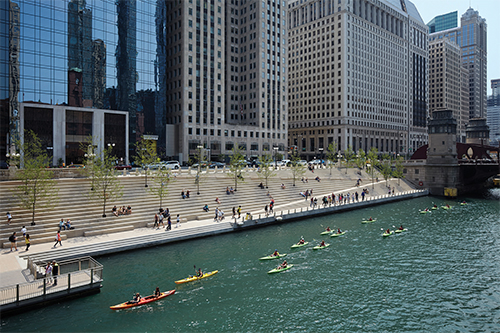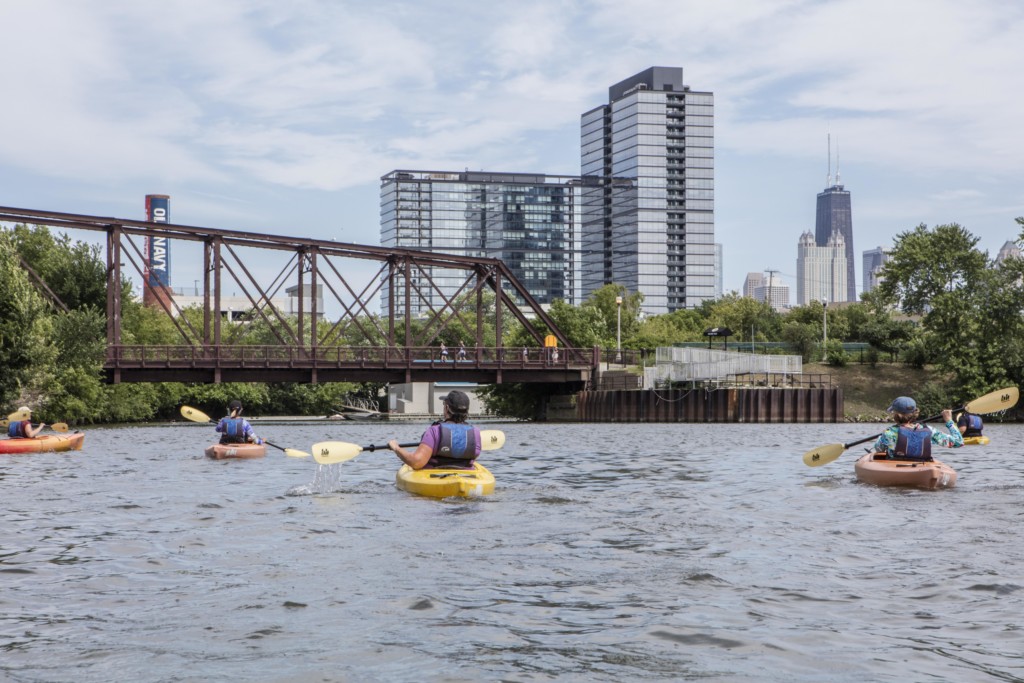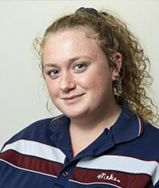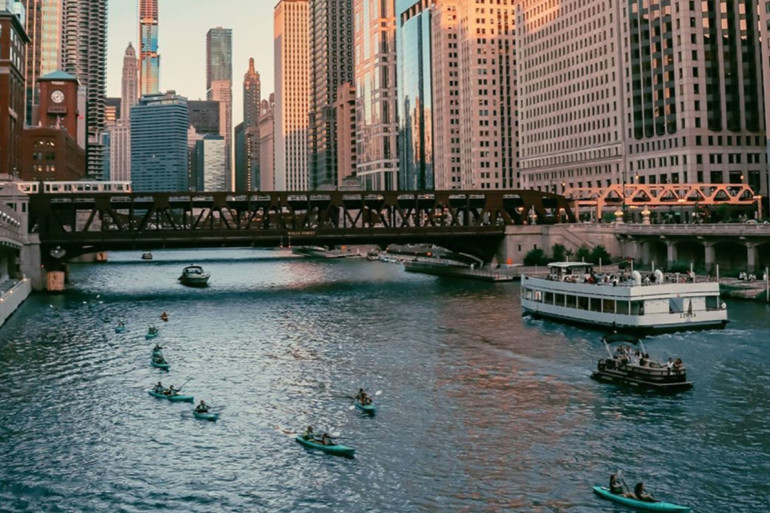What is often forgotten about Chicago is its humble origin story. One of the world’s great cities emerged from the wild prairie of Illinois as Fort Dearborn was established in 1808, and the city later built around it. At the time, wildlife not only populated the area, but was drawn to it in great thanks to the Chicago River, the waterway that breathed life into the city.
The history of the Chicago River and its two fellow rivers, the Calumet and Des Plaines, is marred by negative connotations: that what lurks under the surface is nothing but waste and ecological despair. The waterway’s current reality is much brighter — countless creatures and plant-life call the river their home as it snakes through the city, rife with environmental opportunities. Thankfully, there are a number of local organizations committed to undoing the damage and restoring not only the ecological health of the water but Chicagoans’ opinion of the river as well.
Inviting, Living and Productive Rivers
Organizations like Metropolitan Planning Council — a nonprofit planning and policy organization that was founded in 1934 to create a more equitable and sustainable Chicago region — supports the river’s health and accessibility by approaching the issue from multiple angles. The MPC has instituted programs in the city to champion social needs such as access to housing and transportation, and their mission to make the waterways more equitable, inhabitable and accessible to community members is no different.
“In 2016, MPC and the city of Chicago — with some additional partners — released the Our Great Rivers vision which is this idea of creating more inviting, living, productive rivers and this unifying vision for Chicago’s three rivers. … We thought that it was about time for us to put the same amount of attention and investment into that river system, as we put into something like the lakefront. Our tagline is that there’s 26 miles of lakefront in Chicago and there’s 75 miles of river; so 150 plus miles of riverfront that we really need to be paying attention to,” said Chloe Gurin-Sands, Manager of Health Equity & Planning at MPC.
Aside from on-the-ground work, MPC also navigates the policies that come with the territory. The Chicago’s River Ecology and Governance Task Force, for instance, is one of MPC’s avenues in which they can influence progress being made on the waterways in coordination with the city. The task force was instituted in 2019 under former Mayor Rahm Emanuel and was headed up by “key” government forces — the Forest Preserve, Chicago Department of Planning and Development, the Park District and Chicago Department of Transportation — to band together to achieve common goals with respect to bettering the Chicago rivers. There are now nearly 60 organizations a part of the task force.
“I think through working together as a group the goal is to advance policies and practices that can live up to that vision of inviting, living and productive rivers. I think the question is, ‘What needs to change in order for that to happen? How can people work better in order for that to happen?’ And that’s just some of what is being figured out as part of that task force,” said Christina Harris, Director of Land Use and Planning for MPC.
Natural Resource in an Urban Setting

This vision of what is to come is not dreamt upon by MPC alone. Friends of the Chicago River — a nonprofit organization which has labored to improve and protect the Chicago river system for all living things via water and habitat cleanup since 1979 — joins MPC as fellow river enthusiasts as well as another member of the task force. Based on the organization’s name alone it’s no mystery what they do; but to the general Chicago public, why they do the work might be lost on them.
“[We] need to really think about the river as a natural resource. We’re so used to seeing it downtown, where it looks very pretty but it doesn’t look like a natural river. You’ve got restaurants and the high-rise buildings, but really the river is full of nearly 80 [different] species. … So it’s really a vibrant, natural, wild place. And just because parts of it are constructed, it doesn’t mean that it’s not a natural resource,” said Margaret Frisbie, Executive Director of Friends of the Chicago River.
The disconnect between the average Chicagoan and the flowing bodies of water in the heart of town is a gap Friends aims to close. They do so through their more “visible” projects, including an annual Chicago River Cleanup Day, which saw over 2,000 volunteers this year on the 30th anniversary of the project. This event, and others like it, chips away at the glaring obstacles to waterway restoration: pollution and climate change. While material waste is sure to find itself trapped in the banks and currents of the river system, the biggest aggressor to the river’s way of life is actually more water.
“One of the impacts of climate change here in the Chicago area is harder, heavier rainstorms that are a different sort of rain pattern. And so one of the things that has had a dramatic positive impact on the river system is the Tunnel and Reservoir Plan, colloquially ‘Deep Tunnel.’ It’s a series of tunnels and reservoirs that help capture rain water when it falls to store it so it could be treated through a sewage treatment plant before it ends up in the river. And the overflow for that is pipes that just go into the river directly. So when there’s very hard rainfalls, we end up with combined sewer overflows and that means raw sewage and a ton of trash in the waterway,” Frisbie said.
To counteract the damage this does, Friends launched the Chicago Calumet River Watershed Council with the explicit goal of working “across boundaries to manage rain water.” Furthermore, this tangible project will “blanket” the Chicago Calumet River Watershed with nature-based, green infrastructure.
“Basically picture prairie gardens, open space, forest preserves, parks, roadways with green along them where the water could be absorbed into the ground where it falls, as opposed to being channeled into the combined sewer system. And so you manage stormwater that way, which is great … but you are [also] providing wildlife habitat and creating more attractive places to live because hardscape is now green. And that gets at physical and mental health and wellness because studies show that when people experience nature, they actually have better mental and physical health,” Frisbie confirmed.
Bringing People Back to the Water

The journey to restoring the waterways to their original glory is one that will take time, considerate policy shifting and commitment from organizations and the communities they serve. But it will also require actual beautification if it is going to entice both Chicagoans and tourists. That’s where innovative companies like Urban Rivers come into the mix.
What started as an industrial canal in the Chicago River is day-by-day being repurposed into a mile-long floating eco park. “It’s a wildlife friendly park that’s made up of mostly floating elements, but all different types of habitat modifications and additions. And really what we’re trying to do is we’re trying to add a bit of wildlife back into a very urban area,” said Phil Nicodemus, Director of Research at Urban Rivers.
However, the reality of the project is not as simple as plunking down grass in industrial places. There is red tape to get through first, such as the two-year process beginning in 2015 to secure permission and permits to even begin their work. After going back and forth with grassroots funding and securing funds from the city, in 2020 the project finally broke ground.
“Essentially [the pieces of floating wetlands] are made in Scotland. We get them shipped over in a big shipping container; take them to some port here; take them on a truck; bring them over to us; we unload them; we put them together; we plant them; and then we put them in the water and anchor them,” Nicodemus said of the lengthy process to introducing the new plant life into the canal. “We’re really just trying to maximize the plants that we get along the River’s edge and trying to minimize the amount of work and structure that we have to put in. Those are two really important things, especially in an urban environment.”
Nicodemus made note of the old hardscape sea walls at the river’s edge and its inclination for issue. One of which is its likelihood to bar visitors from recreating in the area and enjoying the built-in nature of the city — an issue MPC echoed as well. Therefore, the end goal for this specific segment of the river — though far from a stopping point for Urban Rivers — is to be able to complete the Wild Mile section and equip it with the greenery and accessibility necessary for leisure and water sports like kayaking; an activity most don’t even associate when thinking of the river.
“When people come to the Wild Mile we’re really trying to get folks exposed. A lot of people think still about [when the river was] declared, in the 1920s, a bubbling and festering cesspool. It is just really not like that anymore,” Nicodemus continued.
To break away from the city’s perception of the river, organizations like Urban Rivers and Friends of the Chicago River are establishing events to bring the community together to show the river is not the wasteland people think it is.
To encourage this connection, Urban Rivers is hosting a block party on June 25 to celebrate the opening of the “floating walkway” at the Wild Mile. A day that will include food, outdoor activities and a lot of support for the oldest natural resource in the city. Friends of the Chicago River, too, has grand plans for the summer including a “Summer Float Party” on August 14. During which 500 people will join Friends to float down the river in inflatable tubes and toys as a gesture to show just how far the river has come, and just how much fun could be had if we embraced it.
Frisbie concluded with an earnest call to action for Chicagoans: “People should get out on the river. They should see it for themselves. They should explore it. There’s just so much to it. And once you start getting out there, I think people fall in love with the river in a whole new way.”
More from Better:
- What’s That on the Horizon? The Upcoming Chicago Summer Sailing Season
- James Beard Foundation Awards Bring the Culinary World’s Stars to Chicago; Chicagoans Erick Williams and Julia Momosé Among the Winners
- Loyola Leading for Good: 2022 Innovator in Social Business Awards Puts a Spotlight on Corporate Good and Sustainability

Margaret Smith is a Chicago-based writer and editor with a passion for socio-political storytelling about their community. They are a graduate of Columbia College Chicago.

